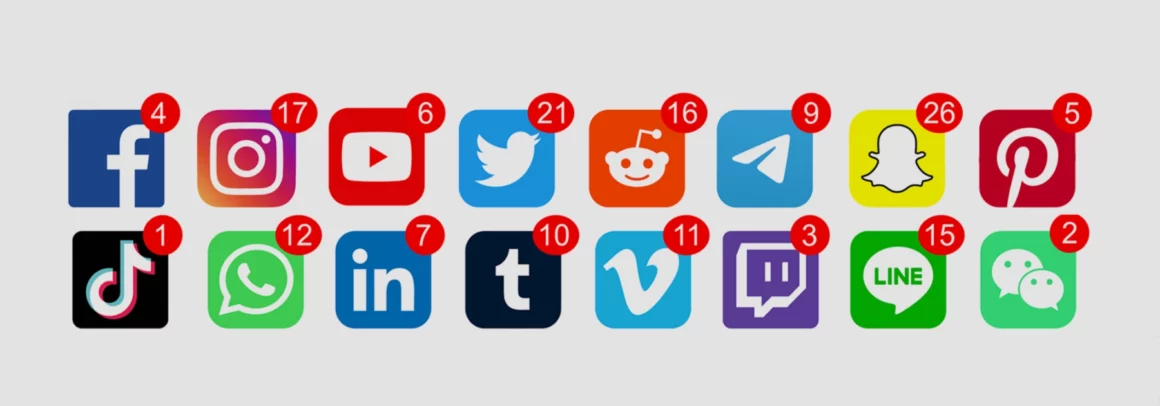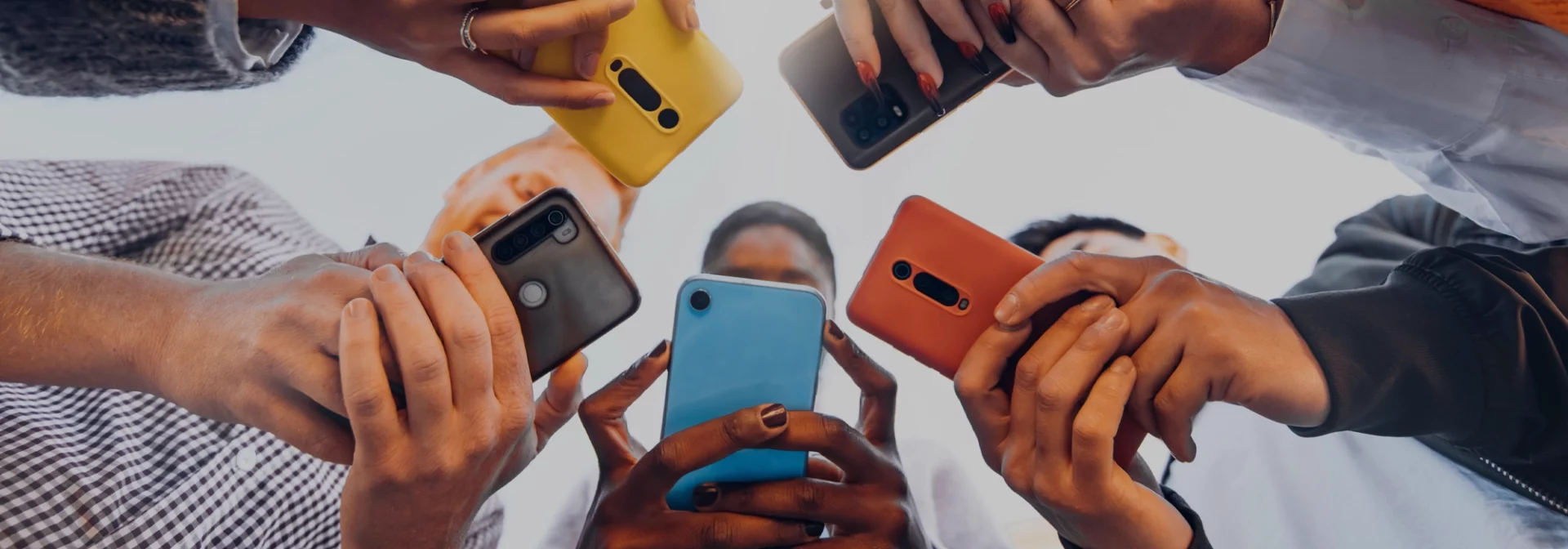Though social media sites like Facebook, Instagram, TikTok, and Snapchat require users to be at least 13 years old to create accounts (in accordance with federal law), it isn’t uncommon for young people to lie about their age to gain access to the site or app. By accessing these platforms before age 13, however, children and preteens are at an increased risk of encountering inappropriate content and/or contact from older users.
As caregivers, it’s important to build some awareness around how these social media sites work, what the appeal is for our young people (even if we are not users), and how to keep our kids safer while using them.
When Should Kids Have Their First Social Media Account?
Preteens and teens are anxious to connect with one another — particularly after feeling such a lack of connection during the height of the COVID-19 pandemic and beyond. This is driven, in part, by the fact that preteens and teens are developmentally designed to need peer-to-peer connection and to place heavy emphasis on the importance of friends. For these reasons and more, your kids may want social media accounts to connect with their friends — and others — at increasingly younger ages.
A report by Common Sense Media revealed that roughly half of all kids have some form of social media account by age 12. When they looked even closer, they found that 80% of teens ages 13-18 have their own social media account, and only 23% of preteens ages 8-12 have an account. Given that the Child Online Privacy Protection Act (C.O.P.P.A.) prevents companies from gathering data from children under the age of 13, we can infer that large numbers of preteens are lying to gain access to these accounts, either with or without their caregivers’ knowledge.
So, when is the right age to have their first account?
There is no one correct age for their first social media account, though some professionals suggest waiting at least until the eighth grade, or when they show a growth in maturity. This is a family decision. It is not advisable, however, to allow their tween to lie about their age online — the slope is far too slippery.

Tips Before Your Tween or Teen Gets Their First Social Media Account
Whether your young person gets a social media account before or after age 13, here are some critical safety measures you should help them take.
Educate Yourself on the Platforms
Take the time to learn about the social platforms they wish to use and walk through the set-up with them. As you do this, be sure to lock down and apply all privacy settings possible.
Make sure that only people who your young person has friended will be able see their profile or any content they post, and emphasize the importance that they never post publicly. In addition, return to the platforms regularly to ensure that their privacy settings remain up-to-date and active. Many social media sites regularly add security settings and it is wise to take advantage of those when offered.
Set Up Strong Passwords
Help them set up a strong password to help prevent fraud, hacking, and identity theft. Passwords need to be strong, long, and unique. No online site or app should use the same password as any other. To make it easier to generate and “remember” unique passwords, tools like LastPass can be very useful.
As a caregiver, you should have access to the password for all social media sites at all times, and should conduct spot-checks inside your young person’s account. Although some adolescents will find ways around this, it is an important piece in the larger puzzle of safety, the focus of which should be helping young people ultimately develop their own sense of responsibility.
Turn Off Location Tagging
Although GPS features are useful when using the maps feature of a phone, all other location-tagging should be turned off and disabled. Make sure that your young person understands the importance of never allowing themselves or their phone to be geotagged through a social media post or other phone app, including through “check-ins.”
Further, children need to understand the importance of never sharing personal details like phone numbers, their address, or school location, and should never discuss having been somewhere on social media until after they have returned home.

Emphasize Good Digital Wellness & Citizenship
Establish rules and guidelines for practicing good digital wellness and citizenship (time and location limitations, online behavior, content limitations, etc.) and online safety and consider agreeing upon and signing a contract for behavior.
Only Accept Friend Requests From People You Know in Real Life
Establish a clear rule that your young people are only to “friend” people or accept two-way connection requests from people they know in real life. Unfortunately, the internet and social media are key places where predatory behavior and other criminal intentions are permitted to flourish.
If their account is already established, ensure their account is set to private vs public. Go through their friends and followers list with them and ask them to remove anyone they don’t know (and trust).
Remind them that on certain social media platforms (Instagram and TikTok) they can still enjoy the benefits of following their favorite bands, artists, sports stars, and celebrities while maintaining a private account and not allowing those individuals to follow them back.
Further, don’t just tell them to block, unfriend and/or report anyone who makes harassing, threatening, or inappropriate comments — walk through the steps and actually show them how to do it and then check back in a few days.
Audit Their Page and Posts
Help your young person look at their page and posts and remove any personal or inappropriate images or content. Discuss implications of posting such content, such as safety concerns with online exploitation or even consideration for their personal and eventually professional reputation.
Acknowledging the Addictive Nature of Social Media
Everyone has read or heard of the potentially addictive nature of digital devices, including cell phones. And, when it comes to managing a young person’s cell phone and social media usage, it is far easier to establish healthy boundaries and rules around social media usage before they get their first phone or social media account rather than after. But, if you have never set rules around these things, or if you are observing any of these “red flag” behaviors in your young person, it may be time to establish/reinforce some new guidelines.
Signs Your Teen Might Be Addicted to Social Media
- “Nomophobia” or a fear of being without the phone
- Lying about smartphone usage
- Difficulty completing obligations at work, school, or home
- Isolation from loved ones
- Obsessively checking accounts (messages, emails, texts and monitoring “likes”)
- Reducing or limiting participation in previously enjoyed activities
- Checking the phone in the middle of the night
- Mood swings related to phone usage
- Inability to entertain or self-soothe without the phone
- Feeling disconnected
- Significant difficulty limiting phone use
If your young person is truly demonstrating addictive behaviors, two things will be important. First, establishing boundaries at home that promote a healthy relationship with their devices, and second, obtaining outside support.

Establishing Boundaries Around Social Media
Establishing rules and boundaries will not always be welcomed by your preteens and teens, but it is the key to avoiding addictive behaviors, as well as an important piece of remedying them. Ongoing conversations about the use of digital devices and social media is important, as is linking usage backed values. Framing rules and boundaries in the context of values will make them much more accessible and meaningful to children, preteens, and teens.
Here are some important things to consider:
Filter, Block, and Monitor Content
Depending on the age of your kid, filtering, blocking, and monitoring content is important.
This is like sitting in the passenger seat with your hand on the break when they first learn to drive. As they get older, and more skilled, and demonstrate responsibility, respectfulness, and awareness in their cell phone usage you can “move to the backseat,” and give them some increased freedom online.
The goal should be to eventually let them drive on their own; when they become adults they are going to have to manage these devices on their own, so it’s critical that we give them increasing opportunities to learn how to do that.
Sign a Digital Media Contract
Consider establishing a digital media contract with your young person. While this type of contract is only as good as the intentions of the people entering into it, for many young people it can help remind them of agreed-upon boundaries and establish consequences in advance for any broken rules.
To be truly effective, the provisions of the contract should be discussed and agreed upon before finalizing and signing and should be revisited at least every 6 months or so. Make sure you recognize that contracts are not a “set it and forget it” kind of a deal. Your tween or teen will still make safety mistakes, they will still say and do things they regret, and will still need reminding about proper etiquette and behavior.
Further, any contract will be more effective if the provisions apply to all parties — you included. For example, if the rule is “no cell phones at the dinner table,” then as role models, we must also avoid bringing our phone to the table.

Seek Professional Help
If setting and enforcing boundaries is not enough to curtail behavior in your house, however, seek some outside help. Caregivers can start with their pediatrician and by seeking out a therapist or coach skilled at working with adolescents. Beyond that, programs specifically developed to address digital challenges may prove helpful. Here are some resources to get you started:
- MePowerment (coaching)
- Healthy Gamer Coaching (coaching)
- restart (residential treatment program)
- Newport Academy (residential and nonresidential treatment)
When handled well and supervised effectively, social media can be a means to positive connection and community for our young people. Use caution and seek to be as thoughtful and intentional as possible as you help their young people venture into the world of Facebook, Instagram, Snapchat, TikTok, and other similar platforms.
